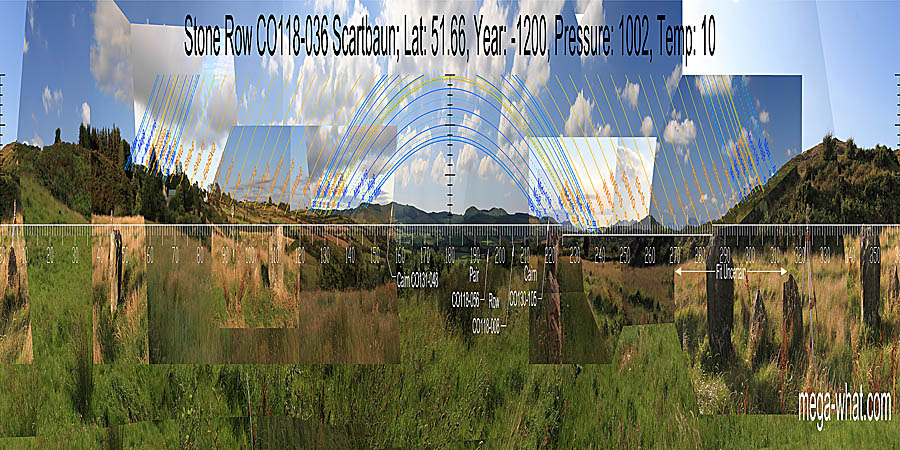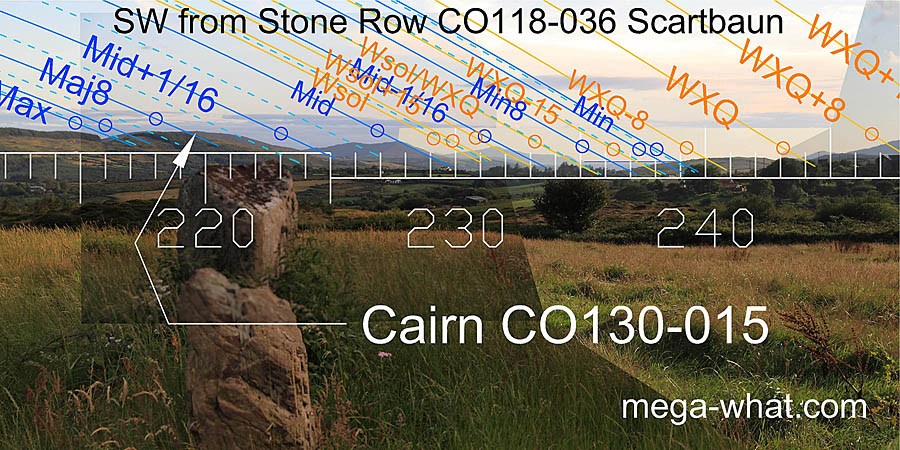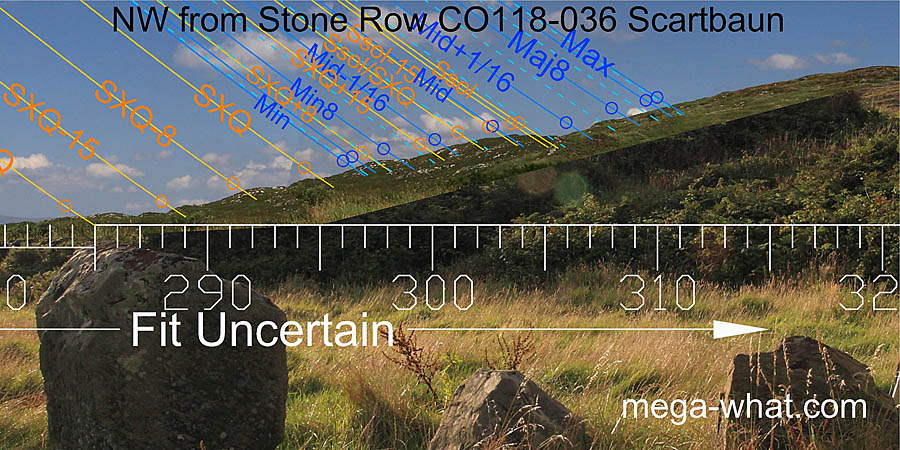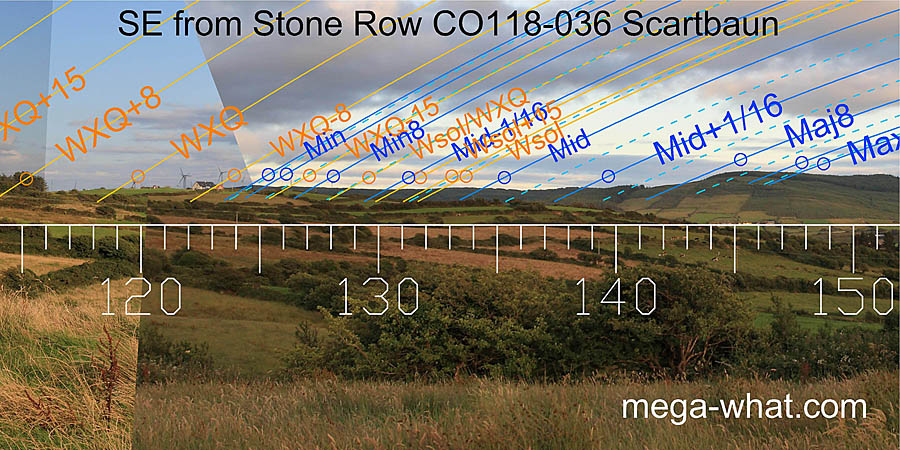 Scartbaun Stone Row is about 2.5km south of Bantry.
Scartbaun Stone Row is about 2.5km south of Bantry.South is on a rise within a distant dip [Pic].
North is in a dip of the local hilltop [Pic].
 The row axis indicates the western slope of Mt Corrin. From just east of the summit to just west of the west basal intersect notch,
according to Ruggles (1999,1996,1995) who also recorded the declination of the summit (Cairn CO130-015).
This nicely demonstrates that monument orientations are rarely supposed to indicate a specific event,
rather they are saying "look over there" to someone who already understands what it's all about and will recognise it for what it is.
The row axis indicates the western slope of Mt Corrin. From just east of the summit to just west of the west basal intersect notch,
according to Ruggles (1999,1996,1995) who also recorded the declination of the summit (Cairn CO130-015).
This nicely demonstrates that monument orientations are rarely supposed to indicate a specific event,
rather they are saying "look over there" to someone who already understands what it's all about and will recognise it for what it is.
The south-western horizon is an excellent example of a good lunisticeLunistices are the most northerly and southerly moons of the month. The lunar equivalent of solstices - more. range with the major landscape features all representing lunar points. The winter-solstice's half-month bracket is there of course, sharing the position of a lunar sixteenth as it does, and the solstice / cross-quarter midpoint also has a good mark, at the end of the peninsula. The minor standstillLunistice positions vary cyclically over an 18.6 year period but are fairly static for more than a year at either end of the range of the moon is at a sea/land intersect of the south side of the bay.
 The western view is down the Muintirvara peninsula, with winter cross-quarter at the foot of the most distant hill.
Its half-month bracket is a dip and so is the cross-quarter / equinox midpoint.
The equinox's half-month bracket is on top of the nearest hill with its quarter-month bracket at the intersect with local ground.
The western view is down the Muintirvara peninsula, with winter cross-quarter at the foot of the most distant hill.
Its half-month bracket is a dip and so is the cross-quarter / equinox midpoint.
The equinox's half-month bracket is on top of the nearest hill with its quarter-month bracket at the intersect with local ground.
 The north-west is obscured by local hedges but this is what it should look like.
The north-west is obscured by local hedges but this is what it should look like.
 North-eastwards, the axially indicated horizon is beyond the moon's most extreme rising point which makes it clear that the south-west orientation is the significant one.
North-eastwards, the axially indicated horizon is beyond the moon's most extreme rising point which makes it clear that the south-west orientation is the significant one.
 The eastern horizon falls on a nearby ridge, the profile of which is confused by vegetation and buildings.
The eastern horizon falls on a nearby ridge, the profile of which is confused by vegetation and buildings.
 The south-east horizon has clearly been used to mark out the lunisticeLunistices are the most northerly and southerly moons of the month. The lunar equivalent of solstices - more.
range but is now mostly forested. WXQ-8, the solar delimiter of the lunisticeLunistices are the most northerly and southerly moons of the month. The lunar equivalent of solstices - more.
range is at the near/far intersect.
The minor standstillLunistice positions vary cyclically over an 18.6 year period but are fairly static for more than a year at either end of the range
is on a high point as is the winter solstice. The major standstillLunistice positions vary cyclically over an 18.6 year period but are fairly static for more than a year at either end of the range
is on the western slope of a hill and that hill's top is at a division of the cycle that is 1/32 beyond the eighths, bounding a 3 year period around the
standstillLunistice positions vary cyclically over an 18.6 year period but are fairly static for more than a year at either end of the range.
The south-east horizon has clearly been used to mark out the lunisticeLunistices are the most northerly and southerly moons of the month. The lunar equivalent of solstices - more.
range but is now mostly forested. WXQ-8, the solar delimiter of the lunisticeLunistices are the most northerly and southerly moons of the month. The lunar equivalent of solstices - more.
range is at the near/far intersect.
The minor standstillLunistice positions vary cyclically over an 18.6 year period but are fairly static for more than a year at either end of the range
is on a high point as is the winter solstice. The major standstillLunistice positions vary cyclically over an 18.6 year period but are fairly static for more than a year at either end of the range
is on the western slope of a hill and that hill's top is at a division of the cycle that is 1/32 beyond the eighths, bounding a 3 year period around the
standstillLunistice positions vary cyclically over an 18.6 year period but are fairly static for more than a year at either end of the range.
Also visible on that skyline is the site of Cairn CO131-048 but with a declination of -32.9° it is too far south to be significant from this location.
This stone row is one of a number in the area that are almost certainly related. The nearest are: Derreengreanagh, c.680m to the east and Keilnascarta, c.1160m to the south-west.
References
- Archaeological Survey of Ireland, record details. www.archaeology.ie/archaeological-survey-ireland
- Ó'NUALLÁIN, SEÁN 1988 Stone Rows in the South of Ireland. Proceedings of the Royal Irish Academy 88c:179-256, p236, no.47.
- POWER, D. et al. 1992 Archaeological Inventory of County Cork, Volume 1: West Cork. Dublin: Stationary Office. p38, no.163.
- RUGGLES, C.L.N. 1999 Astronomy in Prehistoric Britain and Ireland. Newhaven & London: Yale University Press. CKR80.
- RUGGLES, C.L.N. 1996 Stone Rows of Three or More Stones in South-West Ireland. Archaeoastronomy 21 (Journal of the History of Astronomy xxvii) S55-S71.
- RUGGLES, C.L.N. & Burl, H.A.W. 1995 Astronomical Influences on Prehistoric Ritual Architecture in North-Western Europe: The Case of the Stone Rows. Vistas in Astronomy 39:517-528. Oxford: Elsevier Science Ltd.
